Wie handelt man Megaphon-Muster?
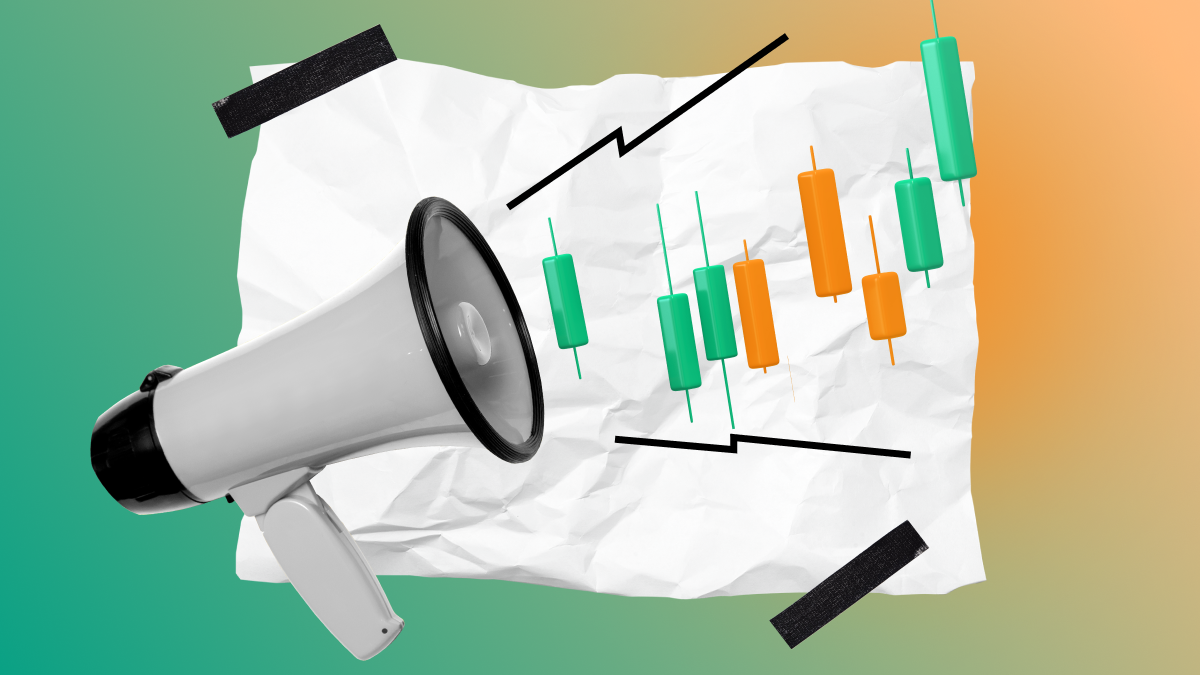
Was ist ein Megaphon-Muster?
Ein Megaphon-Muster ist ein Chartmuster, das auftritt, wenn die Kursbewegung unbeständig wird. Es besteht aus mindestens zwei höheren Hochs und zwei niedrigeren Tiefs, die sich aus fünf verschiedenen Schwankungen ergeben. Jede Schwankung ist größer als der vorherige, und die höheren Hochs und die niedrigeren Tiefs können durch zwei divergierende Trendlinien verbunden sein, die der Form eines Megaphons ähneln und dem Muster seinen Namen geben.
Man kann das Muster in der Regel an der Spitze oder am Ende eines Marktes beobachten. Es zeigt, dass die Händler sich der Marktrichtung nicht sicher sind und versuchen, bei der nächstbesten Gelegenheit in den Handel einzusteigen oder auszusteigen, wodurch größere Schwankungen entstehen.
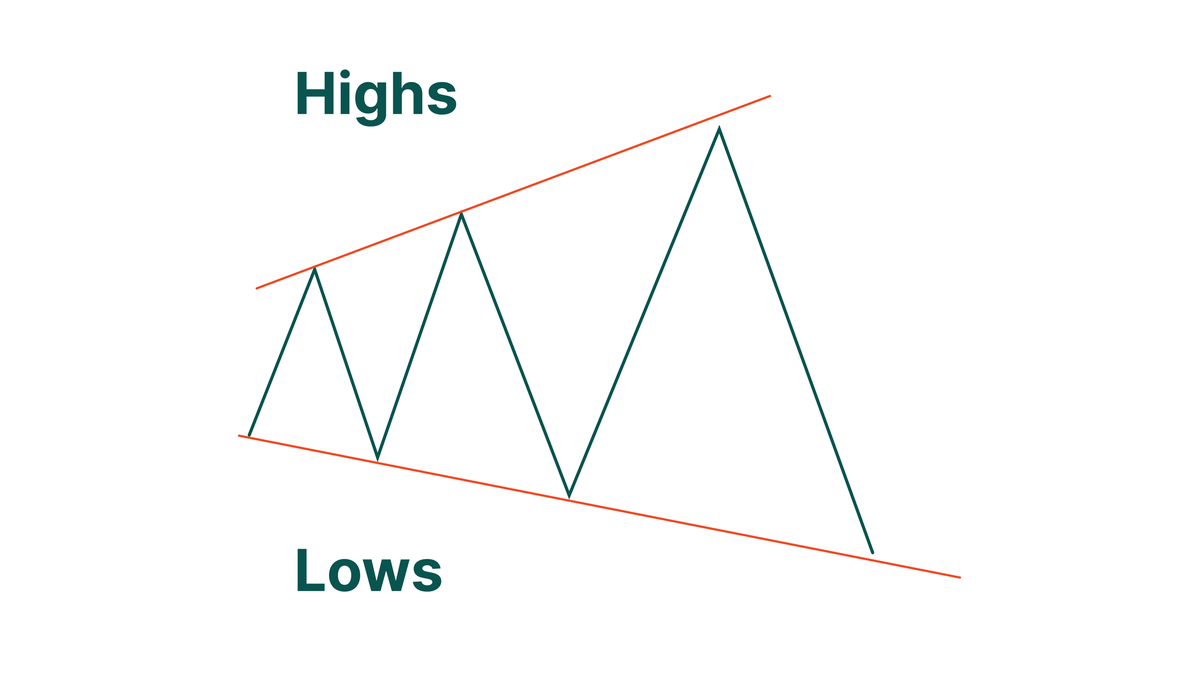
In diesem Artikel lesen Sie, wie Sie ein Megaphon-Muster erkennen können, ob ein Megaphon-Muster bullisch oder bärisch ist, die wichtigsten Merkmale dieses Musters und wie Sie es handeln können, wenn Sie es auf einem Chart entdecken.
Wichtigste Erkenntnisse:
- Megaphon-Muster treten in volatilen Märkten auf, wenn Bullen und Bären um die Kontrolle des Marktes kämpfen.
- Ein Megaphon-Muster besteht aus fünf Schwankungen, die mindestens zwei höhere Hochs und zwei niedrigere Tiefs bilden. Wenn die Trendlinien, die durch die höheren Hochs und die niedrigeren Tiefs gezogen werden, divergieren, handelt es sich um ein Megaphon-Muster.
- Megaphon-Muster können sowohl bullisch als auch bärisch sein, aber es ist unmöglich, mit Sicherheit zu sagen, um welches Muster es sich handelt, bis der Kurs außerhalb des Musters schließt und den Beginn eines neuen Trends oder eine Fortsetzung des vorherigen Trends bestätigt.
- Händler können Megaphon-Muster in verschiedenen Handelsstrategien einsetzen, je nachdem, welchen Handelsstil sie bevorzugen und ob das Muster fehlschlägt oder nicht.
Wie erkennt man Megaphon-Muster?
Wie bereits erwähnt, besteht ein Megaphon-Muster aus fünf Schwankungen, die höhere Hochs und tiefere Tiefs bilden. Wenn Sie einen Kurs sehen, der sich in ähnlichen Schwankungen innerhalb einer immer größer werdenden Spanne bewegt, können Sie überprüfen, ob es sich wirklich um ein Megaphon-Muster handelt, indem Sie zwei Trendlinien einzeichnen: eine durch die höheren Hochs und eine durch die niedrigeren Tiefs. Wenn die Trendlinien in entgegengesetzte Richtungen divergieren, haben Sie es definitiv ein Megaphon-Muster.
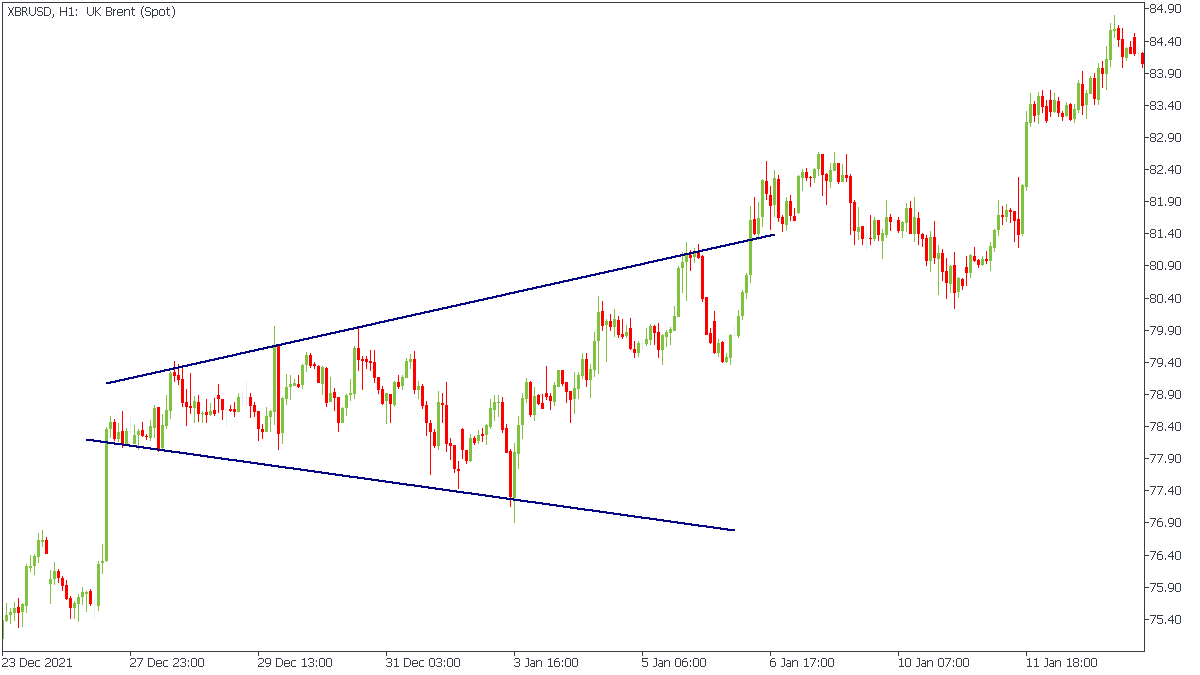
Sie sollten auch wissen, wann und warum ein Megaphon-Muster auf einem Chart erscheinen kann. Megaphon-Muster treten auf, wenn ein Markt eine Phase der Volatilität durchläuft. Sie deuten nicht auf einen bestimmten Preistrend hin. Vielmehr zeigt es an, dass sich die Händler nicht auf den Preis eines Vermögenswerts einigen können. Sie geben ihren Emotionen nach und beginnen zu kaufen, wenn der Preis ihnen niedrig erscheint, und zu verkaufen, wenn er hoch erscheint. Diese Schwankungen hindern den Kurs daran, einem bestimmten Trend zu folgen, was zu weiterer Unentschlossenheit unter den Händlern führt.
Natürlich gehen auch solche Phasen der Volatilität einmal zu Ende, deshalb gibt es gute Strategien, die es besonnenen Händlern ermöglichen, ein Megaphon-Muster zu ihrem Vorteil zu nutzen. Das Wichtigste für sie ist, Ruhe zu bewahren und sich ihre Entscheidungen nicht von der Panik diktieren zu lassen.
Ist es ein bullisches oder ein bärisches Muster?
Ein Megaphon-Muster kann sowohl bullisch als auch bärisch sein, je nachdem, wo auf dem Chart es sich gebildet hat. Aus diesem Grund werden Megaphon-Muster üblicherweise in ein Megaphon-Top und ein Megaphon-Bottom unterteilt.
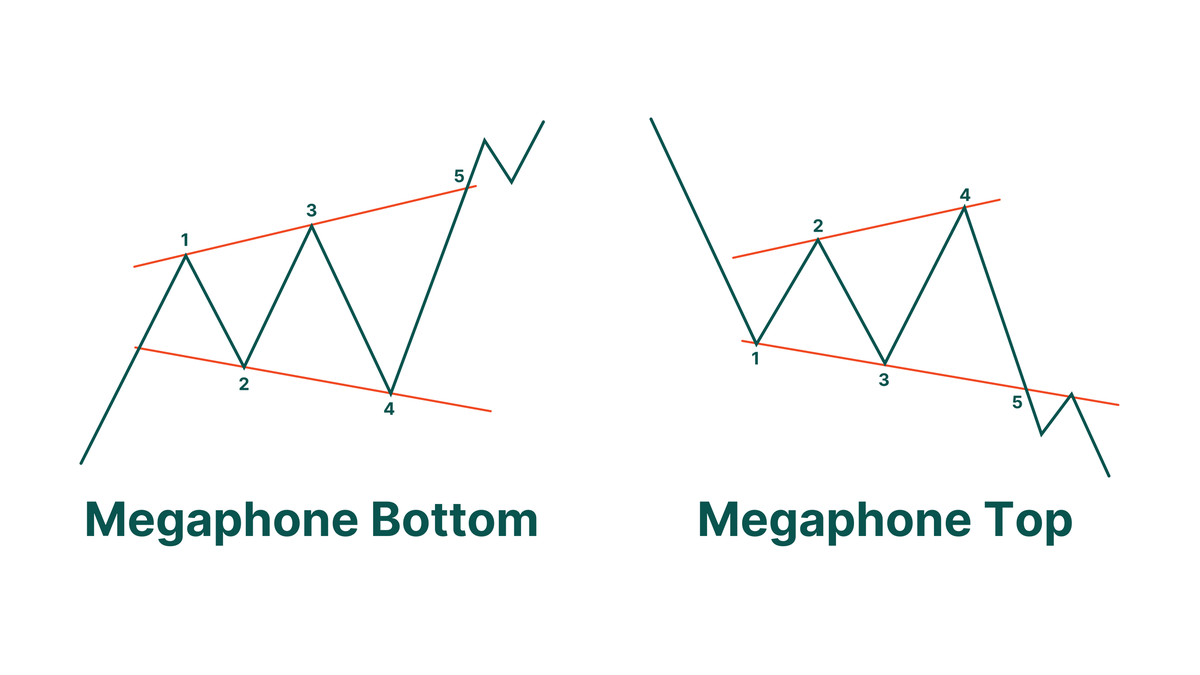
- Ein Megaphon-Top ist ein bärisches Megaphon-Muster, das auf eine mögliche Umkehr von einem Aufwärtstrend zu einem Abwärtstrend oder auf die Fortsetzung eines Abwärtstrends hinweist. Im Allgemeinen besteht ein Megaphon-Top aus drei höheren Höchstständen und zwei niedrigeren Tiefstständen. Das Muster gilt als vollständig, wenn der Kurs die durch die Tiefpunkte des Musters gezogene Trendlinie durchbricht. Wenn dies geschieht, ist die Wahrscheinlichkeit sehr groß, dass der Markt in einen neuen Abwärtstrend übergeht.
- Ein Megaphon-Bottom gilt als weniger häufig als sein bärisches Gegenstück. Im Gegensatz zu einem Megaphon-Top ist ein Megaphon-Bottom ein bullisches Megaphon-Muster, das vor einer potenziellen Umkehr von einem Abwärtstrend zu einem Aufwärtstrend auftritt oder eine Fortsetzung eines Aufwärtstrends anzeigt. Dieses Muster umfasst in der Regel drei niedrigere Tiefststände und zwei höhere Höchststände. Nach dem dritten Tiefpunkt bewegt sich der Kurs in der Regel in einem Aufschwung und durchbricht die durch die Höchststände gezogene Trendlinie, was den Abschluss des Musters und den Beginn eines neuen Aufwärtstrends signalisiert.
Es ist jedoch unmöglich zu sagen, ob diese Megaphon-Muster der Umkehr oder der Fortsetzung eines Trends vorausgehen. Um die Richtung des künftigen Trends sicher herauszufinden, ist es besser zu warten, bis der Kurs die Unterstützungs- oder Widerstandslinie durchbricht und das Muster bestätigt wird. Erst dann ist es sicher, ein Geschäft zu tätigen.
Was ist eine Broadening-Formation?
Eine Broadening-Formation ist ein anderer Name für das, was wir heute als Megaphon-Muster kennen. Broadening-Formationen können sowohl bullisch (breiter werdende Unterseite) als auch bärisch (breiter werdende Oberseite) sein und weisen im Allgemeinen auf eine potenzielle Trendumkehr hin.
Betrachtet man jedoch das Gesamtbild, so sind Broadening-Formations vor allem als Volatilitätsindikatoren bekannt. Sie bilden sich, wenn ein Markt eine Phase höheren Risikos durchläuft. Dies geschieht, weil die Händler unsicher sind, wohin sich der Kurs als Nächstes bewegen wird, und er daher zwischen steigenden und fallenden Kursen schwankt.
Diese Formationen treten auch häufiger während der Gewinnsaison auf, wenn die Unternehmen ihre Quartalsgewinne bekannt geben. Je nachdem, ob ein Unternehmen erfolgreich war oder nicht, reagieren die Händler unterschiedlich optimistisch oder pessimistisch, was die Kursbewegung beeinflusst und zur Bildung eines Megaphon-Musters führen kann.
Merkmale eines Megaphon-Musters
Da wir nun wissen, was ein Megaphon-Muster ist, wollen wir seine wichtigsten Parameter genauer untersuchen.
Volumen
Der erste Parameter eines Megaphon-Musters, auf den Sie achten sollten, ist das Volumen. Wie Sie vielleicht wissen, ist das Volumen ein technischer Indikator, der die Gesamtmenge eines Vermögenswerts darstellt, die während eines bestimmten Zeitraums gehandelt wurde. Das Volumen zeigt an, wie viele Händler auf dem Markt aktiv sind und ob der betreffende Vermögenswert derzeit gefragt ist oder nicht. Das Volumen wird von Händlern auch verwendet, um die Fortsetzung oder die Umkehrung eines Trends zu bestätigen. Sie sehen also, dass das Volumen eine ganze Reihe von Informationen über die aktuelle Marktlage liefern kann.
Wenn es um das Volumen geht, hilft es Händlern, ein Megaphon-Muster auf einem Chart zu erkennen. Händler können sehen, dass das Volumen zusammen mit dem Preis innerhalb des Megaphon-Musters ansteigt. Sie können auch feststellen, dass das Volumen im Allgemeinen zunimmt und hoch bleibt, wenn sich das Muster bildet. Das Volumen deutet jedoch nicht auf eine mögliche Umkehr oder Fortsetzung des vorherigen Trends hin, da es nicht ungewöhnlich erscheint, wenn eines von beiden geschieht.
Grundlegendes Verhalten
Als Nächstes werden wir uns das zugrunde liegende Verhalten ansehen. Wie wir gelernt haben, tritt ein Megaphon-Muster auf, wenn Händler versuchen, die Kontrolle über einen Vermögenswert zu erlangen. Die Bullen kaufen weiter und treiben den Preis des Vermögenswerts in die Höhe, während die Bären im Gegensatz dazu versuchen, dieser Entwicklung entgegenzuwirken und den Vermögenswert zu verkaufen, während der Preis hoch ist, was ihn immer weiter nach unten treibt. Die Schwankungen der Kurse bilden immer wieder neue Höchst- und Tiefststände, und wenn Sie zwei Trendlinien durch diese Punkte ziehen, werden Sie feststellen, dass die Linien in unterschiedliche Richtungen divergieren. In der Regel endet diese Ungewissheit und steigende Spannung damit, dass eine Seite von weiteren Aktionen absieht und die andere Seite den Markt dominiert. Das Muster endet damit, dass sich der Trend in die Richtung der siegreichen Seite bewegt und den vorherigen Trend entweder fortsetzt oder umkehrt.
Wie man Megaphon-Muster handelt
Trotz ihrer nicht eindeutigen Natur bieten Megaphon-Muster viele Handelsmöglichkeiten. Megaphon-Händler können in mehrere Strategien eingebunden werden, je nach Handelsstil des Händlers.
Breakout-Geschäfte
Die erste Möglichkeit, mit einem Megaphon-Muster zu handeln, besteht darin, mit Breakouts zu handeln. Ein Breakout tritt ein, wenn der Kurs eine der Trendlinien durchbricht und außerhalb des Musters schließt. Breakouts können bullisch oder bärisch sein, und Händler sehen sie als Bestätigung eines Musters und der Richtung des folgenden Trends.
Um mit Breakouts zu handeln, muss man abwarten, bis der Kurs außerhalb des Musters schließt, um die Vollendung des Megaphon-Musters zu bestätigen, und in den Handel einsteigen, wenn die Richtung der Kursbewegung klar ist. Beachten Sie, dass es besser ist, ein wenig zu warten, um zu sehen, ob der Breakout scheitert, bevor Sie eine Entscheidung treffen.
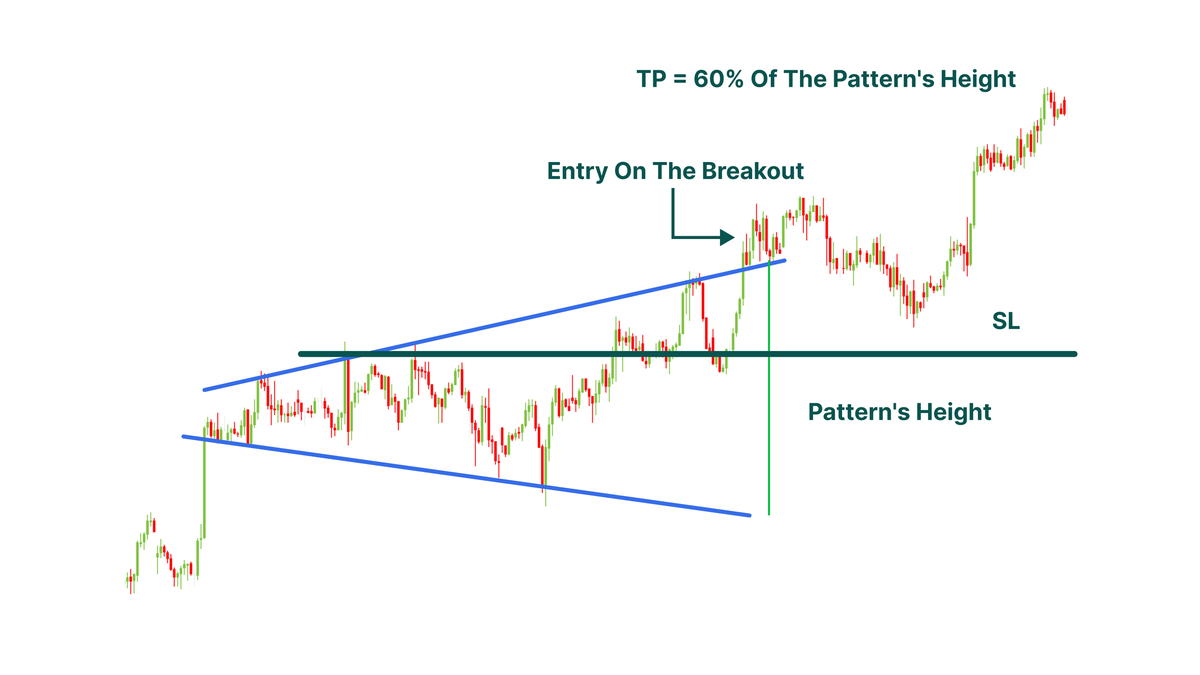
Was das Mindestziel betrifft, so besteht die übliche Strategie darin, den Abstand zwischen dem höchsten Hoch und dem niedrigsten Tief des Musters zu messen, eine Linie mit demselben Abstand vom Breakoutspunkt in Richtung des neuen Trends zu ziehen und dann das Mindestziel bei 60 % der Länge der resultierenden Linie zu setzen.
Für den Stop-Loss wird in der Regel eine Linie durch den zweiten Pivot-Punkt-Hochpunkt (bei einem Aufwärtstrend) oder den zweiten Pivot-Punkt-Tiefpunkt (bei einem bärischen Trend) gezogen und einen Stop-Loss-Auftrag auf diesem Niveau platziert.
Swing-Geschäfte
Da Megaphon-Muster aus mehreren Schwankungen bestehen, eignet sich dieses Muster gut für Swing-Händler. Sie machen sich volatile Märkte zunutze und nutzen die Unentschlossenheit der Mehrheit der Händler zu ihrem Vorteil. Bei Megaphon-Mustern können Swing-Händler versuchen, innerhalb des Musters zu handeln, indem sie kaufen, wenn der Kurs ein neues Tief erreicht, und verkaufen, wenn er ein neues Hoch markiert. Dies erfordert in der Regel, dass sie auf die Bestätigung warten, dass der Kurs eine der Trendlinien nicht durchbrochen hat.
Aber es ist auch möglich, auf Schwankungen innerhalb des Musters zu setzen. Dazu müssen Sie lediglich die horizontalen Linien nutzen, die von den Spitzen und Tälern des Musters gebildet werden, sowie die Pivot-Linie. Darüber hinaus ist es auch möglich, die Fibonacci-Retracement-Levels zu nutzen, um potenzielle Unterstützungs- und Widerstandslinien für den Handel innerhalb des Megaphon-Musters zu finden.
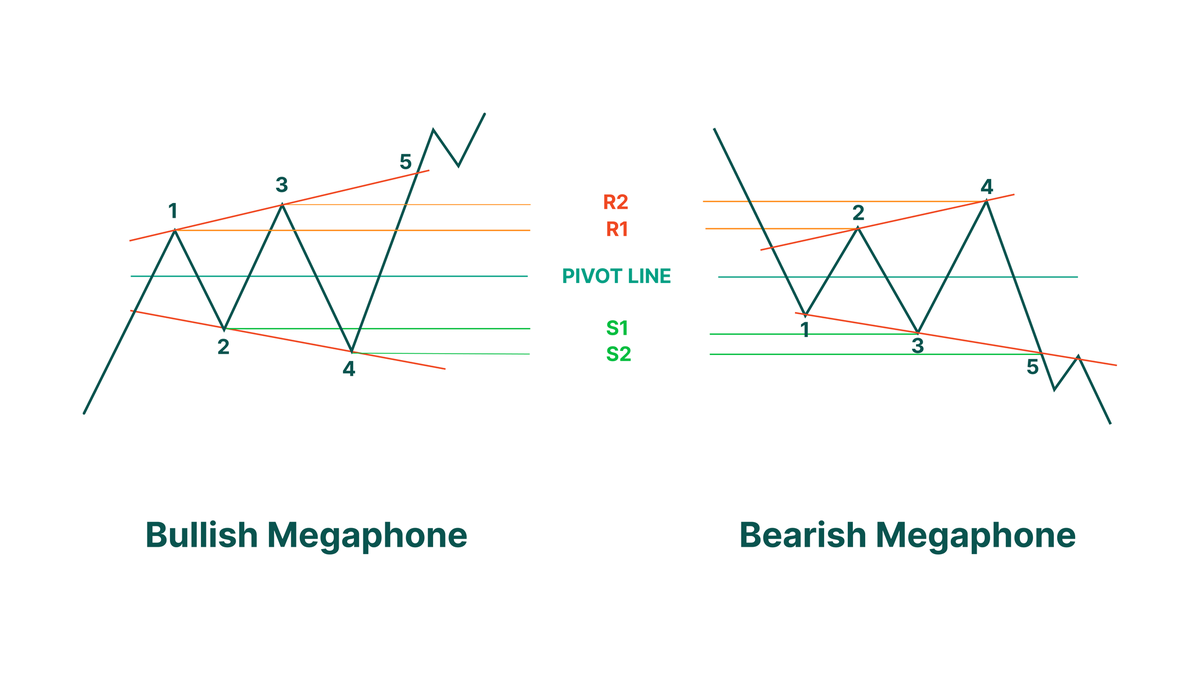
Scheitern
Wie bei jedem anderen Muster kann auch bei einem Megaphon-Muster der Ausbruch scheitern. Trotzdem ist es möglich, mit diesem Muster zu handeln, obwohl es wichtig ist, das Scheitern richtig zu erkennen. Das ist eigentlich recht einfach, denn ein Megaphon-Muster gilt als gescheitert, wenn der Kurs nach der fünften Schwankung nicht eine der Trendlinien durchbricht. Wenn Sie dieses Muster also beispielsweise in einem Bullenmarkt sehen und feststellen, dass der Kurs nach dem fünften Schwankung an einer Trendlinie abprallt, sollten Sie in Erwägung ziehen, zu verkaufen, wenn der Kurs unter die nächstgelegene Unterstützung fällt.
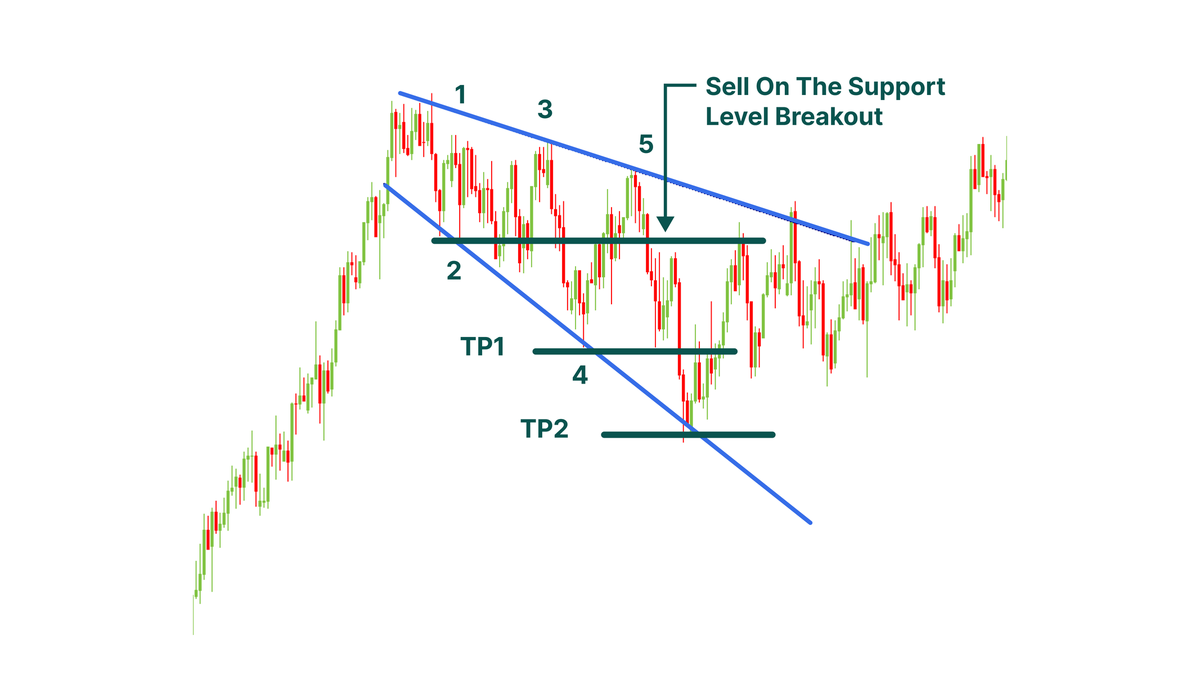
In diesem Fall können Sie die vom Pivot-Punkt 4 gebildeten Niveaus als erstes Handelsziel verwenden und das zweite potenzielle Ziel auf die untere Trendlinie des Musters setzen. Den Stop-Loss können Sie auf dem Niveau platzieren, auf dem der Kurs nach der fünften Schwankung nicht aus dem Muster ausbrechen konnte. Sie können auch das Risiko-Ertrags-Verhältnis entsprechend Ihrer eigenen Handelsstrategie anwenden.
Fazit
In diesem Artikel haben wir etwas über ein Megaphon-Muster gelernt. Ein Megaphon-Muster tritt auf, wenn der Markt eine volatile Phase durchläuft und Händler sich nicht entscheiden können, wie der tatsächliche Preis des betreffenden Vermögenswerts aussehen soll.
Megaphon-Muster können sowohl bullisch als auch bärisch sein, aber es ist schwierig, die Richtung der Kursbewegung vorherzusagen und die besten Ein- und Ausstiegspunkte zu finden, ohne zusätzliche Indikatoren und technische Analysetools zu verwenden.




